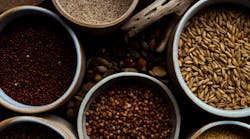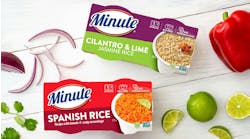Products containing ancient grains and heirloom grains can be found in nearly any section of the grocery store these days, from the bread aisle to the frozen prepared meal section to the specialty beverages cooler.
These grains, such as einkorn, spelt, barley and chia, have some nutritional benefits over modern grains, as well as more distinct taste profiles. Perhaps most importantly, they have captured consumer attention.
“Our sales have gone up significantly year over year,” says Brian Stambaugh, owner of Belle Valley Ancient Grains, a supplier of einkorn, emmer, spelt and flax.
“Over the past three years we’ve had probably triple-digit growth. It seems like there’s more interest among consumers in knowing where their food comes from, connecting it back to the source, and more interest in nutrition.”
Ancient and heirloom grains are growing in popularity, but there are many reasons these ingredients are still just a tiny seed in the bushel basket of commercial grain products. Modern wheat, grown on industrial-size farms and milled into flour, is relatively inexpensive, consistently available and designed for ease of use in commercial food operations. A few ancient grains, such as sorghum and barley, enjoy similar economies of scale, but most ancient grains are generally the opposite – they are grown in small quantities, cost more and require adjustments to recipes and production methods.
“Across the board, my yields are half of my neighbor’s, who grows wheat conventionally,” Stambaugh notes. “In a good year he’ll get 80 bushels per acre, and I average 30 to 40. Part of that is I’m organic so I’m not fertilizing, and my seeds are not hybridized for higher yield.”
Despite the challenges inherent in using these grains, consumers will probably continue to see more and more products made of them on store shelves.
Nutritional value
The myriad nutritional claims of ancient grains suppliers can be traced back to one key fact: These grains contain the measure of nutrients that evolved in them over millennia. Modern grains, in contrast, were bred for yield and ease of production, not nutrition.
Take einkorn for example. This type of wheat grew wild in Mesopotamia and is considered the ancestor of all modern wheat. Remember when hikers in the Italian Alps found a 5,000-year-old body frozen in a glacier? That body had remains of bread made with einkorn in his stomach, presumably part of his last meal.
Research has shown that einkorn has three to four times more beta carotene than modern wheat, twice the vitamin A, and four to five times as much riboflavin. Perhaps most interesting is the fact that einkorn has less gluten than modern wheat.
For bakers that can be a problem, because gluten helps the dough rise and provides a nice texture. But for people with problems tolerating gluten, products made with einkorn instead of modern wheat may be more digestible.
Other ancient grains offer superior nutritional benefits as well. For example, chia seeds, which even the ancient Mayans considered a super food (“chia” translates to “strength” in Mayan), are packed with nutrients such as omega-3 fatty acids, phosphorus, calcium, potassium, iron, zinc and copper.
Benexia, a supplier of chia ingredients, launched a line of chia consumer products called The Seeds of Wellness in 2017. These include chia pasta, chia milk and chia oil. “Chia milk provides the highest omega-3, fiber and protein than any other cow’s milk alternative,” says Sandra Gillot, the company’s CEO.
Barley is an ancient grain that is widely used as in ingredient in pasta, baked goods and beer. It was cultivated as early as 10,000 years ago and is loaded with nutrients including protein, potassium, folate, manganese, iron and vitamin B-6.
Take Two Foods uses upcycled barley – the spent grain left over from beer brewing – to make barleymilk. They source the spent barley from EverGrain, a business that was spawned by and is supplied spent barley from Anheuser Busch.
“Take Two Barleymilk … is packed with wholesome nourishment: at least 5g of complete plant protein per serving; more calcium than dairy milk per serving; and healthy fats, vitamins and minerals,” a spokesperson said.
Another ancient grain that has long been used in commercial food production is sorghum. Lanier Dabruzzi, director of food innovations and institutional markets at United Sorghum Checkoff, notes that this ancient grain is a good source of protein, antioxidants and fiber. And sorghum is gluten free, so it’s ideal for products such as Udi’s Gluten-Free Sandwich Bread and Simple Truth All-Purpose Gluten-Free Flour Mix.
Tastes good
Another advantage of ancient grains, according to suppliers and food manufacturers, is taste.
“A big reason a lot of our customers choose our heritage grains is that they deliver the flavor,” says Debbie LaBell, director of consumer sales at Hayden Flour Mills, which mills flour from ancient grains such as emmer, barley and white sonora, which is one of the oldest wheat varieties in North America. “You’re just not going to find that flavor in other flour.”
Hayden Flour Mills recently began a collaboration with Masienda, a supplier of landrace corn grown on small farms in Mexico (“landrace” refers to a traditional variety of plant or animal that has adapted to its local environment; in other words, not hybridized for large-scale production). The companies produce a tortilla flour made with white sonora from Hayden Flour Mills and Olotillo Blanco heirloom corn from Masienda.
“It’s an amazing flour that makes tortillas that have the texture of a flour tortilla but the flavor of the corn,” LaBell says. “It has been a very popular product – it blew our expectations.”
Stambaugh says his customers also appreciate the flavor advantages of his farm’s ancient grains. “When we started growing these in 2015, we milled them into flour and made bread and pancakes and found the flavor was a lot different from moden wheat. It’s kind of nutty and slightly sweet. I compare it to buying tomatoes from a store versus buying heirloom tomatoes.”
Ardent Mills also touts the flavor advantages of its extensive line of ancient and heirloom grains, which ranges from amaranth to millet to spelt. The company also offers mixtures, such as a gluten-free five-grain blend that includes amaranth, millet, quinoa, sorghum and teff.
An example of unhulled emmer wheat.
“Our line of individual Ancient & Heirloom Grains seeds and flours, and multigrain blends, brings … unique flavor and great-tasting whole grain nutrition to today’s most popular foods — from breads and pizza crusts to breakfast cereals and snacks,” the company says.
Glenn Roberts, founder of Anson Mills, a supplier of heirloom grains, legumes and oil seeds, says that it’s not a coincidence that grains with high nutrition content taste better – those characteristics are intrinsically linked.
“Flavor equals nutrition,” he says. “As you expand the nutrition profile of a food, you expand the aromasensory characteristics.”
Resilient crops, challenging production
Ancient and heirloom grains are tough – after all, they survived countless millennia as wild grains. Modern growers of these grains appreciate those tough characteristics.
For example, einkorn and emmer, another ancient wheat variety, have tough hulls that withstand brutal weather. And they’re accustomed to long dry periods, so irrigation is much less of a problem.
“We heard these grains were much more resilient to changes in the climate and heat, and that piqued our interest because we live in an arid, harsh environment,” says Brooke Lucy, co-owner of Bluebird Grain Farms in Winthrop, Wash. “We thought it would be interesting to see how these ancient wheats did under cultivation here, and we found they are much more resilient than modern wheat.”
This emmer gravity table helps to separate the heavier grains from lighter ones through vibration.
However, the flip side of this resiliency is that the grains that result from these species require extra steps in production. When modern hybrid wheat grains are harvested, their hulls shed off easily as the combine plucks them from the stalks. In contrast, the tough hulls that protect ancient grains from harsh weather cling to the grain, forcing extra steps in the production process before they’re ready for milling.
Some producers remove the tough hulls by shaving them off – this is called “pearling” -- but that also removes at least part of the bran and germ of the grain, which contain much of the nutrients. Pearled grains are also more exposed to oxygen, which hastens their oxidation. Growers who want to preserve the bran and germ need to remove the hulls in a more high-tech fashion.
For example, at Bluebird Grain Farms, a de-huller uses centrifugal force to whip the hulls off. This keeps the grain intact, but conditions -- such as moisture level inside the grain – have to be ideal for the de-huller to work well.
“What we’re finding is that the biggest hurdle is the processing,” Lucy says. “These grains cannot go to the general seed processor.”
The extra work required to dehull the grain, plus the reduced yield of non-hybrid wheat to begin with, means that flour made from ancient and heirloom wheat is generally significantly more expensive than regular wheat flour.
“When you 'combine' a field of modern wheat, the combine hopper is full of wheat. When you combine a field of einkorn or emmer or spelt, the combine does not take the hull off the wheat, so my net yield is less than half,” Stambaugh notes. “Thus the price of einkorn, emmer and spelt is a lot higher than standard wheat.”
Those higher costs will no doubt reduce the overall quantity of ancient and heirloom grain ultimately used in commercial food processing. But as long as customers who are enamored of ancient grains – because of their flavor, nutrition profile or interesting backstory -- are willing to pay a little more, shelf space devoted to ancient and heirloom grain products should continue to grow.


